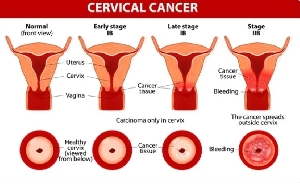Dr Grace Adjoa Ocansey, a clinical epidemiologist, has said no woman must be allowed to die from cervical cancer because the cancer is “preventable and curable.”
She also said that cancer of the cervix “happens when the cells of the cervix begin to change to precancerous cells.
He, however, noted that not all precancerous cells would turn into cancer, thus the need to find these problematic cells early and treat them to prevent the disease and its attendant problems, including death.
Dr Ocansey, who spoke to Ghana News Agency in an interview, said it was time for action against the disease, which “persistently ranks as the second most diagnosed cancer and the second leading cause of cancer deaths among Ghanaian women.
“Everybody including health care providers, churches, youth groups, parents/schools, and civil society groups must get involved to educate and act, so we don’t lose any woman through cervical cancer which is preventable and curable.
Ghana developed a national strategy for cancer control in 2011, which covers strategies for cervical cancer prevention with two objectives to reduce the incidence and mortality of cancer by 30 per cent and improve effective diagnosis and treatment of cancer by 30 per cent but not much has been achieved over the past 10 years, leading to a rise in cervical cancer incidence and mortality in the country.”
“Also, while the World Health Organisation recommended among others vaccination of 90 per cent of girls below 15 years, screening of 70 per cent of women with high-performance tests by 35 years and again by 45 years in Cervical Cancer Elimination Initiative, Human Papillomavirus (HPV) vaccination has not yet been rolled out neither the population-based screening,” she said.
Dr Ocansey said cervical cancer could be categorized into four stages where it is found only in the cervix, spread beyond the cervix and uterus, spread beyond the lower part of the vagina and possibly to pelvic walls, ureters and nearby lymph nodes and lastly, to the bladder, rectum, or other body parts like the bones or lungs.
She underscored the need for women to avail themselves to be screened by a pap test, HPV test, or pelvic exam (visual) for early detection of any precancerous or cancerous lesions for action, saying the cancer could be treated through surgery, radiation therapy, chemotherapy, targeted therapy, cryotherapy and thermal coagulation.
Health News of Monday, 11 March 2024
Source: GNA

















